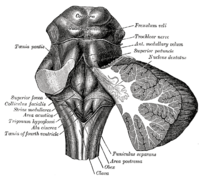
Photo from wikipedia
Post-traumatic stress disorder (PTSD) is a psychological disorder affecting many around the world. Growing evidence suggests that orexin-A is involved in the pathophysiology of depression and panic anxiety disorder. However,… Click to show full abstract
Post-traumatic stress disorder (PTSD) is a psychological disorder affecting many around the world. Growing evidence suggests that orexin-A is involved in the pathophysiology of depression and panic anxiety disorder. However, the role of orexin-A in PTSD remains unclear. Therefore, pharmacological manipulation of orexin-A can be a potential approach for the treatment of PTSD. Male Wistar rats were subjected to stress re-stress (SRS) by restraining them for 2 h followed by foot shock (FS) and halothane exposure on day-2 (D-2). Then the rats were weekly exposed to FS as re-stress cue up to D-32. Suvorexant, an orexin antagonist (10, 20 and 30 mg/kg p.o.) and paroxetine (10 mg/kg p.o.) were administered from D-8 to D-32. Plasma and cerebrospinal fluid (CSF) were collected for corticosterone and orexin-A measurement. The analysis of serotonin and corticotropin-releasing factor receptor-1 (CRF-R1) were performed in the amygdalar tissue. SRS-induced PTSD-like symptoms like fears response, anxiety-like behaviour and hypocorticosteronism were attenuated by suvorexant and paroxetine. Interestingly, SRS exposed rats showed activation of orexin-A and serotonergic systems, which were also attenuated by suvorexant. Additionally, suvorexant ameliorated the extrahypothalamic induced upregulation of CRH-R1 in SRS-exposed rats. Therefore, orexin-A may be considered as a neurochemical-marker for PTSD and suvorexant alleviated PTSD-like symptoms through modulating orexinergic, serotonergic and neuroendocrine systems.
Journal Title: Behavioural Brain Research
Year Published: 2021
Link to full text (if available)
Share on Social Media: Sign Up to like & get
recommendations!